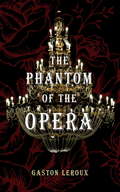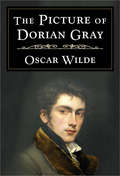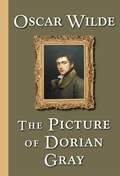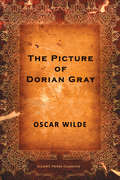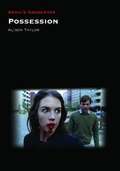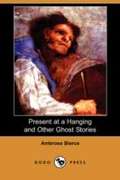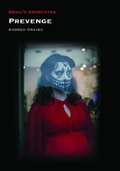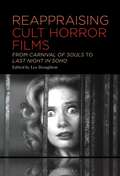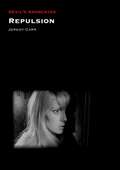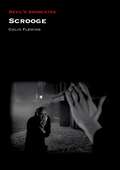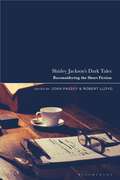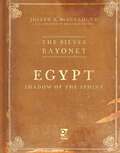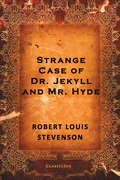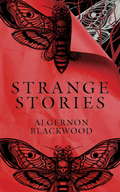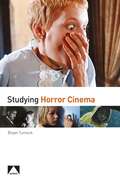- Table View
- List View
The Phantom of the Opera
by Gaston LerouxA classic ghost story, inspired by true events. Christine is an up-and-coming talent at the Paris Opera, so talented and beautiful that she attracts the attention of the opera house's mysterious phantom, in reality a deformed man named Erik. Overcome by love, the Phantom kidnaps her in a bid to make her his bride. It was famously adapted for the stage by Andrew Lloyd Webber in 1986 and to the screen in 1925, with Lon Cheney in the leading role. Penguin Random House Canada is proud to bring you classic works of literature in e-book form, with the highest quality production values. Find more today and rediscover books you never knew you loved.
The Picture of Dorian Gray
by Oscar WildeOscar Wilde's only novel. Dorian Gray sells his soul in a bid to maintain eternal youth and beauty. Only his portrait will age. As with all such bargains, however, there will be a reckoning.
The Picture of Dorian Gray
by Oscar WildeOscar Wilde's only novel. Dorian Gray sells his soul in a bid to maintain eternal youth and beauty. Only his portrait will age. As with all such bargains, however, there will be a reckoning.
The Picture of Dorian Gray
by Oscar WildeDorian Gray believes that the true value of life is revealed only in the pursuit of beauty. As a result, Dorian sells his soul so that a beautiful painting of him will age, while he remains forever young.
Poltergeist (Devil's Advocates)
by Rob McLaughlin'Created’ by Steven Spielberg yet officially directed by Tobe Hooper, Poltergeist (1982) can be best described as ‘family horror movie’ both in its target audience and in its narrative context, the story of an All-American suburban family, the Freelings, whose home suddenly becomes the site of a spectacular haunting, apparently summoned by their young daughter. The film is somewhat of an anachronism and this Devil's Advocate explores this in both the scope of production and narrative. The book discusses the duality of the text highlighting debates surrounding both Spielberg's somewhat saccharine portrayal of middle-class Americana and his more subversive cinematic endeavours. The duality of the text also will also be discussed in the context of the film's production – with both Spielberg and Hooper on set for much of the time, the result was a movie with the production values, effects and marketing of a high budget mainstream cinema blockbuster apparently directed by a subversive 'grindhouse' cinema auteur. Yet Poltergeist is neither nor both of those things, instead being a unique hybrid of genres and styles taking the best and worst from both aspects of family blockbuster and cult horror film, and as such can be seen as a text that is something unique – a classic modern take on the traditional haunted house story.
Possession (Devil's Advocates)
by Alison TaylorPremiering at the 1981 Cannes Film Festival, Andrzej Żuławski’s Possession remains a distinct phenomenon. Though in competition for the illustrious Palme d’Or, its art cinema context did not rescue it from being banned as part of the United Kingdom’s ‘video nasties’ campaign, alongside unashamedly lowbrow titles such as Faces of Death and Zombie Flesh Eaters. Skirting the boundary between art and exploitation, body horror and cerebral reverie, relationship drama and political statement, Possession is a truly astonishing film. Part visceral horror, part surreal experiment, part gothic romance dressed in the iconography of a spy thriller: there is no doubt that the polarity evinced by Possession’s initial release was in part a product of its resistance to clear categorisation.With a production history almost as bizarre as the film itself, a cult following gained with its VHS release, and being re-appreciated in the decades since as a valuable work of auteur cinema, the story of how this film came to be is as fascinating as it is unfathomable. Alison Taylor’s Devil’s Advocate considers Possession’s history, stylistic achievement, and legacy as an enduring and unique work of horror cinema. Beginning with a marital breakdown and ending with an apocalypse, the film’s strangeness has not dissipated over time; its transgressive imagery, histrionic performances, and spiral staircase logic remain affective and confounding to critics and fans alike. Respecting the film’s wilfully enigmatic nature, this book helps to unpack its key threads, including the collision between the banal and the horrific, the socio-historical context of its divided Berlin setting, and the significance of its legacy, particularly with regard to the contemporary trend for extreme art horror on the festival circuit.
Present at a Hanging and Other Ghost Stories
by Ambrose BierceAmbrose Gwinnett Bierce (1842-1914) was an American editorialist, journalist, short-story writer and satirist, today best known for his The Devils Dictionary (1911). He wrote some of his books under the pseudonyms Dod Grile and J. Milton Sloluck. Bierces lucid, unsentimental style has kept him popular when many of his contemporaries have been consigned to oblivion. His dark, sardonic views and vehemence as a critic earned him the nickname, "Bitter Bierce. " Such was his reputation that it was said his judgment on any piece of prose or poetry could make or break a writers career. His short stories are considered among the best of the 19th century, providing a popular following based on his roots. He wrote realistically of the terrible things he had seen in the war in such stories as An Occurrence at Owl Creek Bridge, Killed at Resaca, and Chickamauga. His works include: The Fiends Delight (1873), Cobwebs from an Empty Skull (1874), Black Beetles in Amber (1892), Fantastic Fables (1899), Shapes of Clay (1903), A Son of the Gods, and A Horseman in the Sky (1907), Write It Right (1909) and A Cynic Looks at Life (1912).
Prevenge (Devil's Advocates)
by Andrew GravesPrevenge (2016) is an entertainingly dark 21st-century horror movie detailing the serial killing journey of heavily pregnant Ruth. It’s a cleverly crafted narrative full of stark social commentary, traversing the delicate line between comedy and tragedy by fusing together a kitchen sink approach with a supernatural revenge plot. This book, as part of the Devil’s Advocates series, examines how the film deconstructs the slasher mythology and the sexism therein, and upends stereotypical representations of the ‘weak’ woman and ‘delicate’ mother. With new exclusive input from writer, director and star Alice Lowe, the text also looks at the production’s inception and development, assesses its debts to cult British cinema, and inspects its umbilical connections to Rosemary’s Baby, Alien, Village of the Damned and many other ‘Monstrous Child’ silver screen features.
The Raven, The Masque of the Red Death, The Cask of Amontillado
by Edgar Allan Poe[This text is listed as an example that meets Common Core Standards in English language arts in grades 11-12 at http://www.corestandards.org.]
Re-Animator (Devil's Advocates)
by Eddie FalveySince its release at the mid-point of the 1980s American horror boom, Stuart Gordon’s Re-Animator (1985) has endured as one of the most beloved cult horror films of that era. Greeted by enthusiastic early reviews, Re-Animator has maintained a spot at the periphery of the classic horror film canon. While Re-Animator has not entirely gone without critical attention, it has often been overshadowed in horror studies by more familiar titles from the period. Eddie Falvey’s book, which represents the first book-length study of Re-Animator, repositions it as one of the most significant American horror films of its era. For Falvey, Re-Animator sits at the intersection of various developments that were taking place within the context of 1980s American horror production. He uses Re-Animator to explore the rise and fall of Charles Band’s Empire Pictures, the revival of the mad science sub-genre, the emergent popularity of both gore aesthetics and horror-comedies, as well as a new appetite for the works of H.P. Lovecraft in adaptation. Falvey also tracks the film's legacies, observing not only how Re-Animator’s success gave rise to a new Lovecraftian cycle fronted by Stuart Gordon, but also how its cult status has continued to grow, marked by sequels, spin-offs, parodies and re-releases. As such, Falvey's book promises to be a book both about Re-Animator itself and about the various contexts that birthed it and continue to reflect its influence.
Reappraising Cult Horror Films: From Carnival of Souls to Last Night in Soho
Identifies key – and in some cases previously overlooked – cult horror films from around the world and reappraises them by approaching and interrogating them in new ways.New productions in the horror genre occupy a prominent space within the cinematic landscape of the 21st century, but the genre's back catalogue of older films refuses to be consigned to the motion picture graveyard just yet. Interest in older horror films remains high, and an ever-increasing number of these films have enjoyed an afterlife as cult movies thanks to regular film festival screenings, television broadcasts and home video releases. Similarly, academic interest in the horror genre has remained high. The frameworks applied by contributors to the collection include genre studies, narrative theory, socio-political readings, aspects of cultural studies, gendered readings, archival research, fan culture work, interviews with filmmakers, aspects of film historiography, spatial theory and cult film theory. Covering a corpus of films that ranges from recognised cult horror classics such as The Wicker Man, The Shining and Candyman to more obscure films like Daughters of Darkness, The Legend of the 7 Golden Vampires, Shivers, Howling III: The Marsupials and Inside, Broughton has curated an international selection of case studies that show the diverse nature of the cult horror subgenre. Be they star-laden, stylish, violent, bizarre or simply little heard-of obscurities, this book offers a multitude of new critical insights into a truly eclectic selection of cult horror films.
Repulsion (Devil's Advocates)
by Jeremy CarrRoman Polanski’s Repulsion (1965), starring Catherine Deneuve as a repressed and tormented manicurist, is a gripping, visually inventive descent into paranoia and self-destructive alienation. Emblematic of recurrent Polanski motifs, evinced in his student short films, in his striking debut feature, Knife in the Water (1962), and in subsequent features like Death and the Maiden (1994), Repulsion is a tour de force examination of crippling anxiety and the sinister potency of inanimate objects. Repulsion amplifies the realm of psychological horror by evoking the seething impact of increasing delusion, literal and figurative seclusion, and the consequences of one woman’s foreboding sensitivity to the unsettling world that surrounds her. This Devil’s Advocate considers Repulsion within the context of familiar horror tropes and the prevailing qualities of Polanski’s broader oeuvre. Drawing on the research of Sigmund Freud, Julia Kristeva, Barbara Creed and others, concerning issues of abjection, the ‘monstrous-feminine’, and the psychology of horror spectatorship, this text focuses on central themes of isolation, sexuality and setting. Bookended by introductory biographical details and concluding with a roundup of the film’s reception, Jeremy Carr situates Repulsion within the horror genre at large as well as its various off-shoots, such as the rape/revenge subgenre. There is also an analysis of the film’s technical qualities, from its sound design to its brilliantly low-key special effects, all of which define the film as Polanski’s most audaciously stylish realisation of dread and unease.
Scrooge (Devil's Advocates)
by Colin FlemingThis Devil’s Advocate explores the cinematic wonders of Brian Desmond Hurst’s much loved 1951 adaptation of A Christmas Carol, Scrooge, through the prism of horror cinema, arguing that the film has less in common with cosy festive tradition than it does with terror cinema like James Whale’s Bride of Frankenstein, Robert Weine’s The Cabinet of Dr. Caligari, and F.W. Murnau’s Faust. Beginning with Charles Dickens himself, a prolific writer of ghost stories, with A Christmas Carol being but one of many, Colin Fleming then considers earlier cinematic adaptations including 1935’s folk-horror-like Scrooge, before offering a full account of the Hurst/Sim version, stressing what must always be kept at the forefront of our minds: this is a ghost story.
Shirley Jackson’s Dark Tales: Reconsidering the Short Fiction
The first dedicated exploration of the short fiction of Shirley Jackson for three decades, this volume takes an in-depth look at the themes and legacies of her 200-plus short stories. Recognized as the mother of contemporary horror, scholars from across the globe, and from a range of different disciplinary backgrounds, dig into the lasting impact of her work in light of its increasing relevance to contemporary critical preoccupations and the re-release of Jackson's work in 2016. Offering new methodologies to study her work, this volume calls upon ideas of intertextuality, ecocriticism and psychoanalysis to examine a broad range of themes from national identity, race, gender and class to domesticity, the occult, selfhood and mental illness. With consideration of her blockbuster works alongside later works that received much less critical attention, Shirley Jackson's Dark Tales promises a rich and dynamic expansion on previous scholarship of Jackson's oeuvre, both bringing her writing into the contemporary conversation, and ensuring her place in the canon of Horror fiction.
Shivers (Devil's Advocates)
by Luke AspellShivers (1975) was David Cronenberg’s first commercial feature and his first horror film. In a modern apartment block, a scientific project to unleash the id results in the equation of passion with contagion and predation. Because the writer-director’s imaginative landscape arrived in the genre fully formed, the unique forms of this début have often been overlooked or mistaken for shortcomings. Cronenberg’s most comedic film until Map to the Stars, Shivers is also his most spectacularly unnerving, throwing more images of extreme behavior at us than any of his subsequent films; it remains, with Crash, his most disquieting and transgressive film to date. Luke Aspell’s analysis addresses all channels of communication available to the 35mm sync-sound narrative feature, including shot composition, lighting, cinematographic texture, sound, the use of stock music, editing, costume, makeup, optical work, the screenplay, the casting, and the direction of the actors. Attending to form the better to see the film in its context, this tour of Shivers as “cognitive territory” takes in architecture, cultural context, critical reception, and artistic legacy.
The Silver Bayonet: Egypt: Shadow of the Sphinx (The Silver Bayonet)
by Mr Joseph A. McCulloughFace dangerous new foes, recruit new soldiers, and uncover the mysterious treasures of Ancient Egypt in two new campaigns, one competitive and one for solo or cooperative play.Somewhere beneath the shifting sands lies the forgotten knowledge of the pharaohs – magic granting power over wind and rain, life and death, and even time itself. Napoleon didn't cross the Mediterranean simply to conquer Egypt, he sought these ancient secrets. No one knows what he found, but his military victories since then speak for themselves. Now, as Bonaparte continues to burn his way through Europe, desperate nations have sent their own special units across the sea to search for a counter and end his rampage.Egypt: Shadow of the Sphinx is a supplement for The Silver Bayonet, in which the players' special units explore the mysteries of this great land, venturing into lost cities, forbidden ruins, and even beneath the Pyramids themselves. Contained within are two campaigns, one competitive and one for solo or cooperative play. Also included is a new recruitment list as well as a number of new soldier types, and the equipment that might give them an edge, but they will still have to face an array of terrifying foes, including mummies, werejackals, and serpopards, many not known to the living for more than 3,000 years...
Snuff (Devil's Advocates)
by Mark McKennaSnuff (1976) occupies a unique place in cinematic history, as the first commercially successful film to capitalise upon the myth of the ‘snuff’ movie. By blending cinema verité styling with a media moral panic, savvy producer Allan Shackleton’s blending of a long-forgotten exploitation film with a newly filmed bloody, if unconvincing conclusion, only served to consolidate the belief that somewhere, at some time, someone was killed on camera in an attack that was as much about the sexual gratification of the film’s intended audience, as it was about the commercial rewards for those producing the film. In the years since its release, the film has been routinely cited as ‘evidence’ of the snuff movie’s existence, contributing to a cultural history that exists outside of the film. This book explores the production, distribution and exhibition of the film Snuff, alongside that cultural history, considering how a scarcely seen exploitation film contributed to a popular understanding of the snuff movie. It assesses the cultural, cinematic and political legacy of the film and asks whether the established definition of what might constitute a snuff movie, that was defined 45 years ago, is sufficient in an attention economy that is based upon participatory culture.
Strange Case of Dr. Jekyll and Mr. Hyde (Pulp! The Classics Ser. #Vol. 263)
by Robert Louis StevensonWhen Gabriel Utterson, a lawyer by trade, becomes concerned about odd changes to a friend's will, he undertakes to investigate the relationship between his friend—Dr. Henry Jekyll—and the mysterious and dangerous Mr. Hyde.Even as Utterson works to sever the relationship between Jekyll and Hyde, Utterson finds himself at odds with Jekyll's own wishes—but is unable to unravel the reasons for mysterious attachment until it is too late.Be it mystery, romance, drama, comedy, politics, or history, great literature stands the test of time. ClassicJoe proudly brings literary classics to today's digital readers, connecting those who love to read with authors whose work continues to get people talking. Look for other fiction and non-fiction classics from ClassicJoe.
Strange Stories
by Algernon BlackwoodA scintillating collection from one of the genre's greats. This compilation contains almost 100 of Algernon Blackwood's weird fiction stories, including classics such as" A Victim of Higher Space," "The Haunted Island," "The Sacrifice," "The Attic," and "Dance of Death," presenting the multi-faceted imagination of a pillar of the genre. Penguin Random House Canada is proud to bring you classic works of literature in e-book form, with the highest quality production values. Find more today and rediscover books you never knew you loved.
Studying Horror Cinema (Auteur)
by Bryan TurnockAimed at teachers and students new to the subject, Studying Horror Cinema is a comprehensive survey of the genre from silent cinema to its twenty-first century resurgence. Structured as a series of thirteen case studies of easily accessible films, it covers the historical, production, and cultural context of each film, together with detailed textual analysis of key sequences. Sitting alongside such acknowledged classics as Psycho and Rosemary’s Baby are analyses of influential non-English language films as Kwaidan, Bay of Blood, and Let the Right One In. The author concludes with a chapter on 2017’s blockbuster It, the most financially successful horror film of all time, making Studying Horror Cinema the most up-to-date overview of the genre available.
